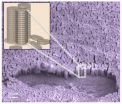(Press-News.org) AMHERST, Mass. – Using a bio-mimicking analog of one of nature's most efficient light-harvesting structures, blades of grass, an international research team led by Alejandro Briseno of the University of Massachusetts Amherst has taken a major step in developing long-sought polymer architecture to boost power-conversion efficiency of light to electricity for use in electronic devices.
Briseno, with colleagues and graduate students at UMass Amherst and others at Stanford University and Dresden University of Technology, Germany, report in the current issue of Nano Letters that by using single-crystalline organic nanopillars, or "nanograss," they found a way to get around dead ends, or discontinuous pathways, that pose a serious drawback when using blended systems known as bulk heterojunction donor-acceptor, or positive-negative (p-n), junctions for harvesting energy in organic solar cells.
Briseno's research group is one of very few in the world to design and grow organic single-crystal p-n junctions. He says, "This work is a major advancement in the field of organic solar cells because we have developed what the field considers the 'Holy Grail' architecture for harvesting light and converting it to electricity." The breakthrough in morphology control should have widespread use in solar cells, batteries and vertical transistors, he adds.
Briseno explains, "For decades scientists and engineers have placed great effort in trying to control the morphology of p-n junction interfaces in organic solar cells. We report here that we have at last developed the ideal architecture composed of organic single-crystal vertical nanopillars." Nanopillars are nanoscale, engineered surfaces with billions of organic posts that resemble blades of grass, and like grass blades they are particularly effective at converting light to energy.
The advance not only addresses the problem of dead ends or discontinuous pathways that make for inefficient energy transfer, but it also solves some instability problems, where the materials in mixed blends of polymers tend to lose their phase-separated behavior over time, degrading energy transfer, the polymer chemist says. Also, materials in blended systems tend to be amorphous to semi-crystalline at best and "this is a disadvantage since charge transport is more efficient in highly crystalline systems."
Specifically, to control the molecular orientation and packing at electrode surfaces, the team combined knowledge about graphene and organic crystals. Though it was difficult, Briseno says, they managed to get the necessary compounds to stack like coins. Stacked compounds are ideal for charge transport since this configuration has the largest charge transport anisotropy. Charge transport anisotropy is a phenomenon where electrons flow faster along a particular crystallographic direction due to close molecule-molecule interactions. In this case, the anisotropy is along the nanopillar, perpendicular to the substrate.
Briseno says, "The biggest challenge in producing this architecture was finding the appropriate substrate that would enable the molecules to stack vertically. We had exploited essentially every substrate possible until we finally succeeded with graphene," he adds, which happened by accident when an undergraduate chose the wrong substrate to grow crystals on.
"For over a week the student was growing vertical crystals and we didn't even realize until we imaged the surface of the substrate with a scanning electron microscope. We were shocked to see little crystals standing upright! We ultimately optimized the conditions and determined the mechanism of crystallization," the polymer chemist adds.
Vertical nanopillars are ideal geometries for getting around these challenges, Briseno says, "because charge separation/collection is most efficient perpendicular to the plastic device. In this case, our nanopillars highly resemble nanograss. Our systems share similar attributes of grass such as high density array system, vertical orientations and the ability to efficiently convert light into energy."
The technique is simple, inexpensive and applicable to a library of donor and acceptor compounds that are commercially available, he notes. "We envision that our nanopillar solar cells will appeal to low-end energy applications such as gadgets, toys, sensors and short lifetime disposable devices."
INFORMATION:
Blades of grass inspire advance in organic solar cells
Using a bio-mimicking analog of one of nature's most efficient light-harvesting structures, blades of grass, a research team has taken a major step in developing long-sought polymer architecture to boost power-conversion efficiency of light to electricity
2014-09-30
ELSE PRESS RELEASES FROM THIS DATE:
Comprehensive Study of allergic deaths in US finds medications are main culprit
2014-09-30
September 30, 2014—(BRONX, NY)—Medications are the leading cause of allergy-related sudden deaths in the U.S., according to an analysis of death certificates from 1999 to 2010, conducted by researchers at Montefiore Medical Center and Albert Einstein College of Medicine of Yeshiva University. The study, published online today in the Journal of Allergy and Clinical Immunology, also found that the risk of fatal drug-induced allergic reactions was particularly high among older people and African-Americans and that such deaths increased significantly in the U.S. in recent ...
The cultural side of science communication
2014-09-30
EVANSTON, Ill. --- Do we think of nature as something that we enjoy when we visit a national park and something we need to "preserve?" Or do we think of ourselves as a part of nature? A bird's nest is a part of nature, but what about a house?
The answers to these questions reflect different cultural orientations. They are also reflected in our actions, our speech and in cultural artifacts.
A new Northwestern University study, in partnership with the University of Washington, the American Indian Center of Chicago and the Menominee tribe of Wisconsin, focuses on science ...
Rating the planet's oceans
2014-09-30
The most comprehensive assessment conducted by the Ocean Health Index rates the Earth's oceans at 67 out of 100 in overall health. In addition, for the first time, the report assessed the Antarctic and the 15 ocean regions beyond national jurisdiction (high-seas areas) — all critical regions for maintaining a healthy climate, safeguarding biodiversity and providing sustainable food sources.
In the third annual update of the index, a partnership led by scientists from UC Santa Barbara's National Center for Ecological Analysis and Synthesis (NCEAS) and Conservation International ...
New diagnostic approach for autism in Tanzania
2014-09-30
PROVIDENCE, R.I. [Brown University] — Autism is no stranger to the children of Tanzania. What is rare in the East African nation is access to clinical services, including reliable diagnosis and evidence-based treatments. There is no autism diagnostic measure, for example, validated for use in Swahili, a major language of the region. In a small new study, however, researchers at Brown University and the University of Georgia (UGA) describe a culturally compatible diagnostic approach that they implemented at two sites in the country and found to be effective for making diagnoses.
The ...
This week from AGU: Measuring Antarctic ice loss, Indian Ocean program, Oregon landslides
2014-09-30
This week from AGU: Measuring Antarctic ice loss, Indian Ocean program, Oregon landslides
From AGU's blogs: Scientists use fiber-optic cables to measure ice loss in Antarctic
Researchers installed moorings containing fiber-optic cables hundreds of meters down into the McMurdo Ice Shelf in West Antarctica to collect temperature information about the base of the ice shelf, where the thick platform of floating ice meets the ocean. The sensors were able to measure mere millimeters of ice loss at the interface, demonstrating that the new fiber-optic method could be ...
Depression increasing across the country
2014-09-30
SAN DIEGO, Calif. (Sept. 30, 2014)— A study by San Diego State University psychology professor Jean M. Twenge shows Americans are more depressed now than they have been in decades.
Analyzing data from 6.9 million adolescents and adults from all over the country, Twenge found that Americans now report more psychosomatic symptoms of depression, such as trouble sleeping and trouble concentrating, than their counterparts in the 1980s.
"Previous studies found that more people have been treated for depression in recent years, but that could be due to more awareness and less ...
Disease decoded: Gene mutation may lead to development of new cancer drugs
2014-09-30
ANN ARBOR—The discovery of a gene mutation that causes a rare premature aging disease could lead to the development of drugs that block the rapid, unstoppable cell division that makes cancer so deadly.
Scientists at the University of Michigan and the U-M Health System recently discovered a protein mutation that causes the devastating disease dyskeratosis congenita, in which precious hematopoietic stem cells can't regenerate and make new blood. People with DC age prematurely and are prone to cancer and bone marrow failure.
But the study findings reach far beyond the ...
New guidelines for treatment of hypothyroidism endorse current therapy
2014-09-30
WASHINGTON (Sept. 30, 2014) — Levothyroxine is considered the gold standard therapy for an underactive thyroid gland (hypothyroidism), and a new review of therapies for the condition — including combining levothyroxine with another agent — has not altered that assessment, say a team of investigators.
1Their analysis, published as a set of guidelines in the journal Thyroid, finds insufficient consistent data exist to recommend a change in use of levothyroxine — whether generic, or sold under various trade names, such as Synthroid® — as the only drug needed to treat hypothyroidism.
"Levothyroxine ...
A new dimension for integrated circuits: 3-D nanomagnetic logic
2014-09-30
This news release is available in German.
Electrical engineers at the Technische Universität München (TUM) have demonstrated a new kind of building block for digital integrated circuits. Their experiments show that future computer chips could be based on three-dimensional arrangements of nanometer-scale magnets instead of transistors. As the main enabling technology of the semiconductor industry – CMOS fabrication of silicon chips – approaches fundamental limits, the TUM researchers and collaborators at the University of Notre Dame are exploring "magnetic computing" ...
Medicaid and Uninsured patients obtain new patient appointments most easily at FQHCs
2014-09-30
PHILADELPHIA – Federally Qualified Health Centers (FQHCs) granted new patient appointments to Medicaid beneficiaries and uninsured patients at higher rates than other primary care practices (non-FQHCs), in addition to charging less for visits, according to results of a new 10-state University of Pennsylvania study published this month in Medical Care.
Using data from a previous "secret shopper" study conducted in 2012 and 2013, the investigators found that FQHCs — community health clinics that receive federal funding to provide primary care access to underserved populations ...
LAST 30 PRESS RELEASES:
A new way to map how cells choose their fate
Numbers in our sights affect how we perceive space
SIMJ announces global collaborative book project in commemoration of its 75th anniversary
Air pollution exposure and birth weight
Obstructive sleep apnea risk and mental health conditions among older adults
How talking slows eye movements behind the wheel
The Ceramic Society of Japan’s Oxoate Ceramics Research Association launches new international book project
Heart-brain connection: international study reveals the role of the vagus nerve in keeping the heart young
Researchers identify Rb1 as a predictive biomarker for a new therapeutic strategy in some breast cancers
Survey reveals ethical gaps slowing AI adoption in pediatric surgery
Stimulant ADHD medications work differently than thought
AI overestimates how smart people are, according to HSE economists
HSE researchers create genome-wide map of quadruplexes
Scientists boost cell "powerhouses" to burn more calories
Automatic label checking: The missing step in making reliable medical AI
Low daily alcohol intake linked to 50% heightened mouth cancer risk in India
American Meteorological Society announces Rick Spinrad as 2026 President-Elect
Biomass-based carbon capture spotlighted in newly released global climate webinar recording
Illuminating invisible nano pollutants: advanced bioimaging tracks the full journey of emerging nanoscale contaminants in living systems
How does age affect recovery from spinal cord injury?
Novel AI tool offers prognosis for patients with head and neck cancer
Fathers’ microplastic exposure tied to their children’s metabolic problems
Research validates laboratory model for studying high-grade serous ovarian cancer
SIR 2026 delivers transformative breakthroughs in minimally invasive medicine to improve patient care
Stem Cell Reports most downloaded papers of 2025 highlight the breadth and impact of stem cell research
Oxford-led study estimates NHS spends around 3% of its primary and secondary care budget on the health impacts of heat and cold in England
A researcher’s long quest leads to a smart composite breakthrough
Urban wild bees act as “microbial sensors” of city health.
New study finds where you live affects recovery after a hip fracture
Forecasting the impact of fully automated vehicle adoption on US road traffic injuries
[Press-News.org] Blades of grass inspire advance in organic solar cellsUsing a bio-mimicking analog of one of nature's most efficient light-harvesting structures, blades of grass, a research team has taken a major step in developing long-sought polymer architecture to boost power-conversion efficiency of light to electricity




